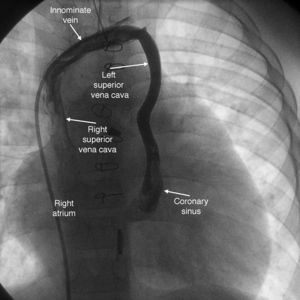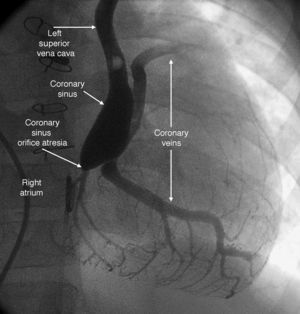A 7-year-old patient with a history of single ventricle anatomy characterized by double inlet left ventricle, mitral stenosis, secundum atrial septal defect, and pulmonary artery band placement in infancy was referred for a Fontan procedure. Angiography of the innominate vein demonstrated the presence of a left superior vena cava (LSVC) with a coronary sinus (CS) connection. The drainage of the innominate vein into the right superior vena cava was normal (Figure 1). Angiography of the LSVC demonstrated atresia of the CS orifice and no connection between the CS and the left atrium. Therefore, the CS drained abnormally into the innominate vein through the LSVC and this pathway was its only egress route (Figure 2). This finding has no clinical consequence when the cardiac anatomy is normal. However, it is relevant in patients with a single ventricle who require a cavopulmonary anastomosis or a Fontan procedure. In these cases, closure of the LSVC, usually performed by catheterization or during surgery to avoid right to left shunting, results in myocardial ischemia when the CS drainage becomes totally occluded. Cavopulmonary anastomosis can be performed without affecting the CS, letting it drain in connection with the pulmonary circulation through the LSVC. The surgical approach proposed in this patient, in conjunction with the Fontan procedure, was to unroof the CS in order to allow its drainage into the left atrium and ligate the LSVC.
Figure 1.
Figure 2.
Corresponding author: at2109@columbia.edu




